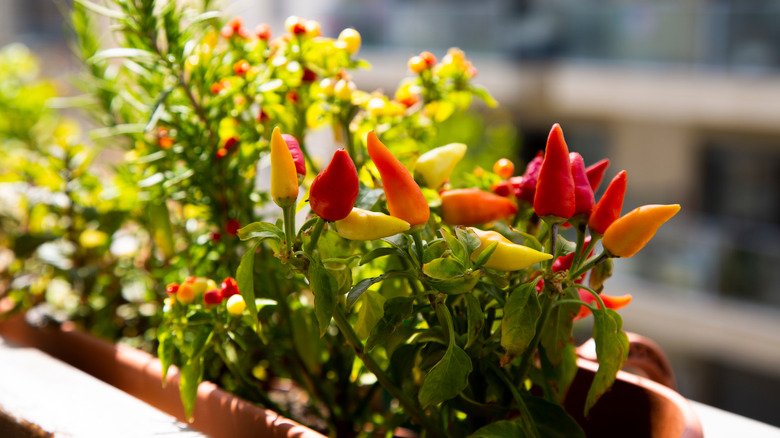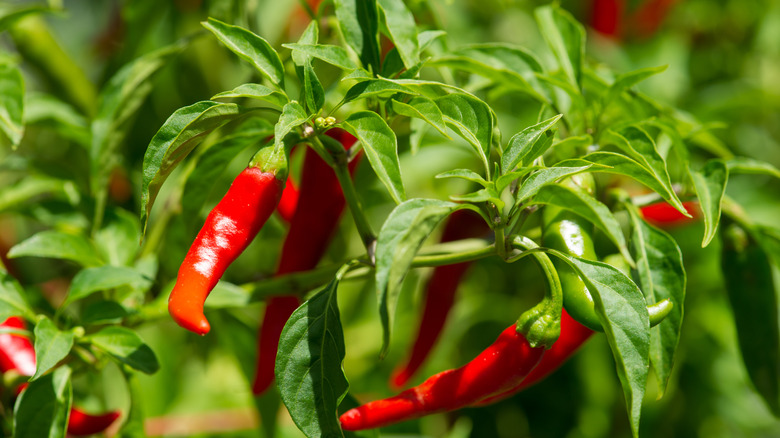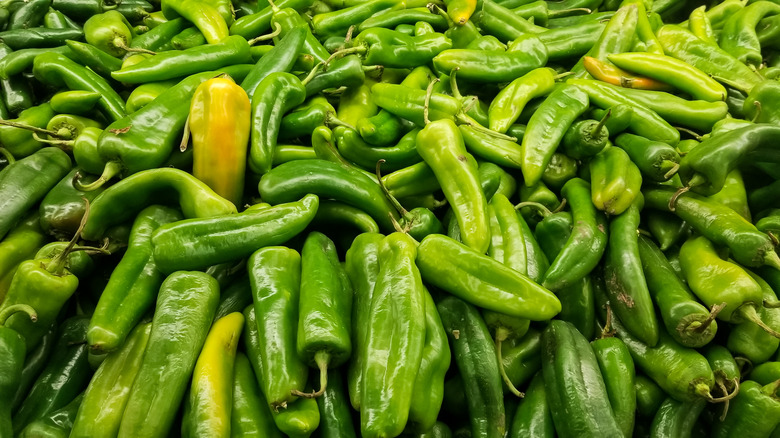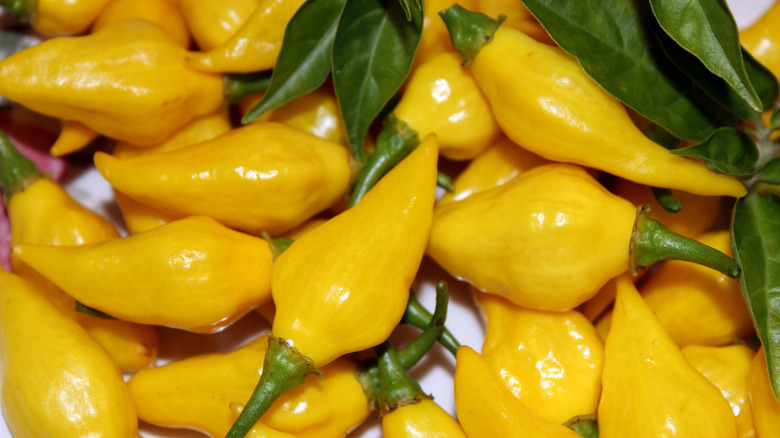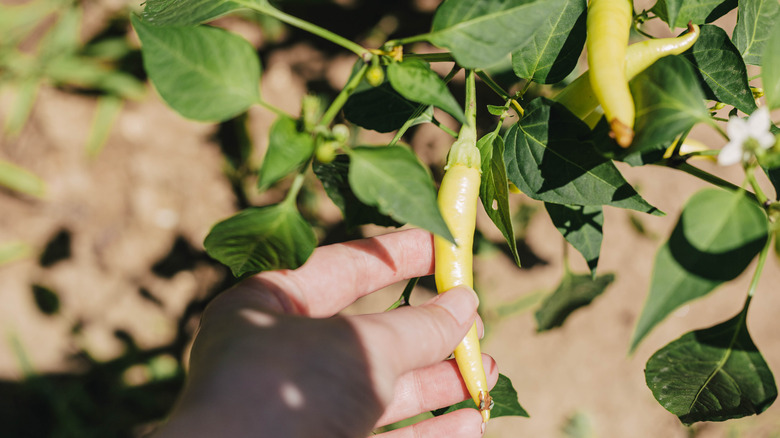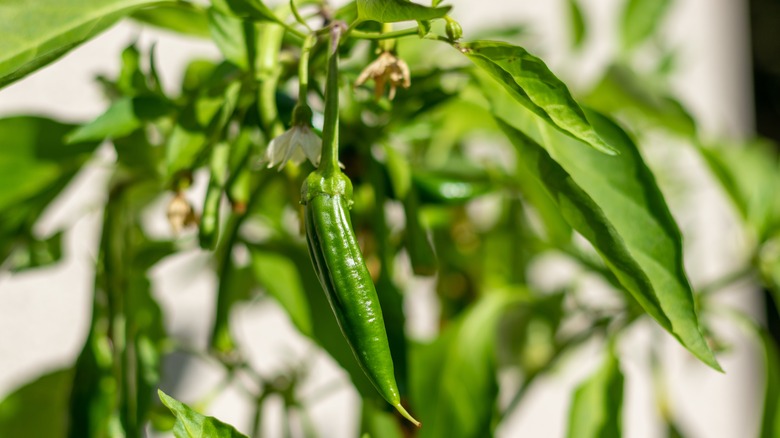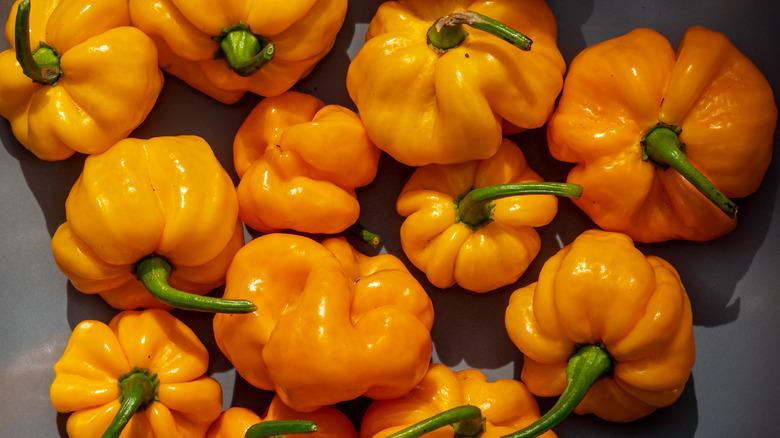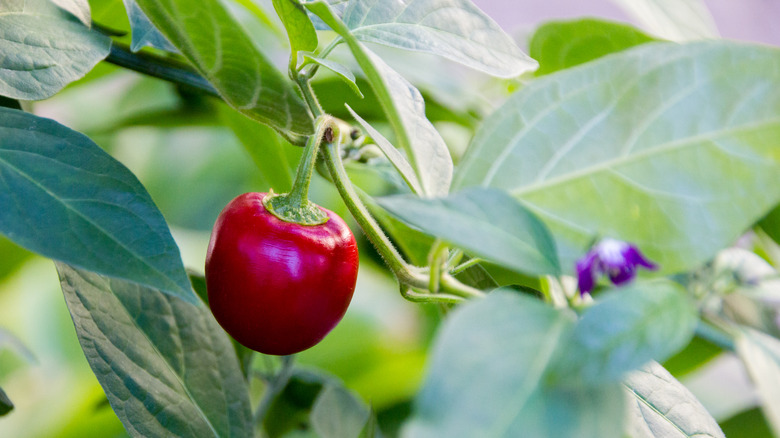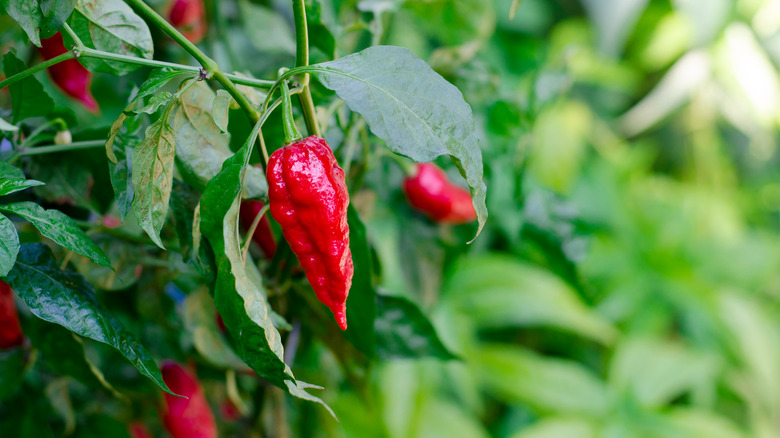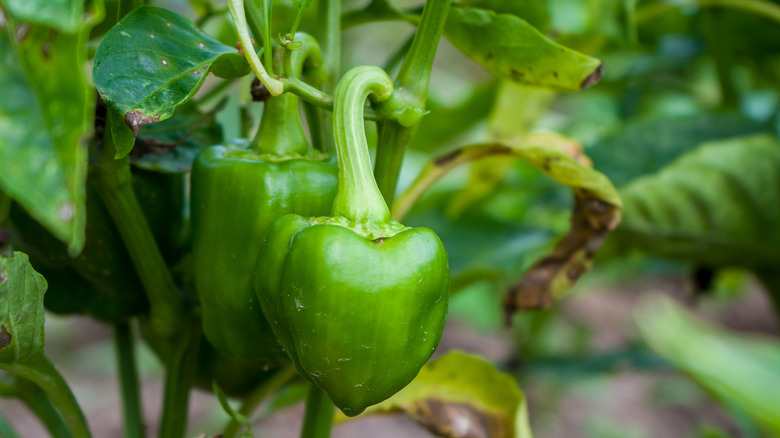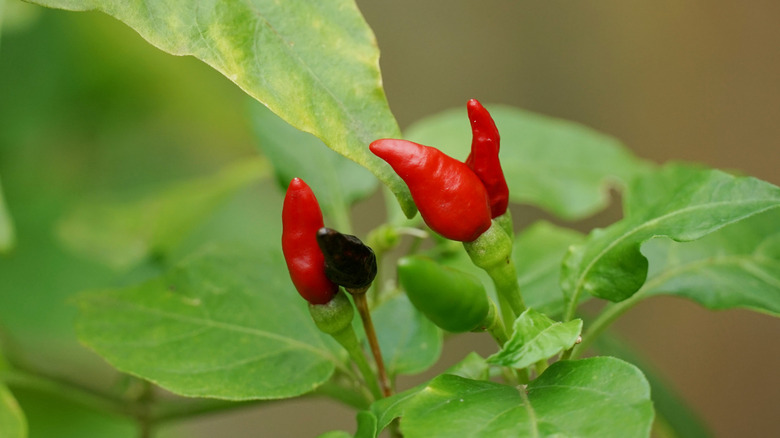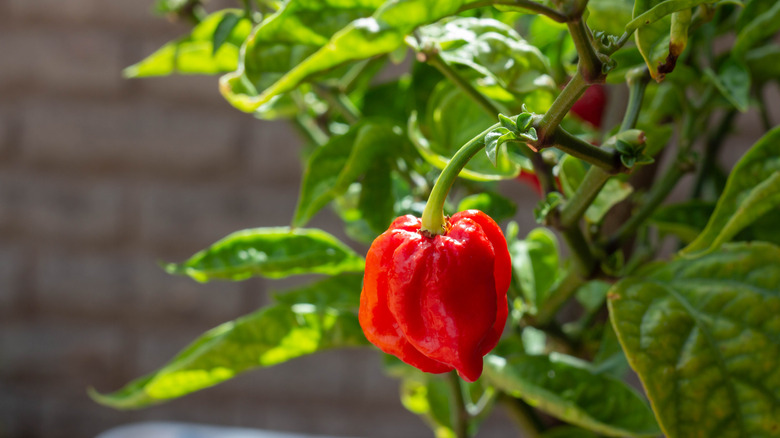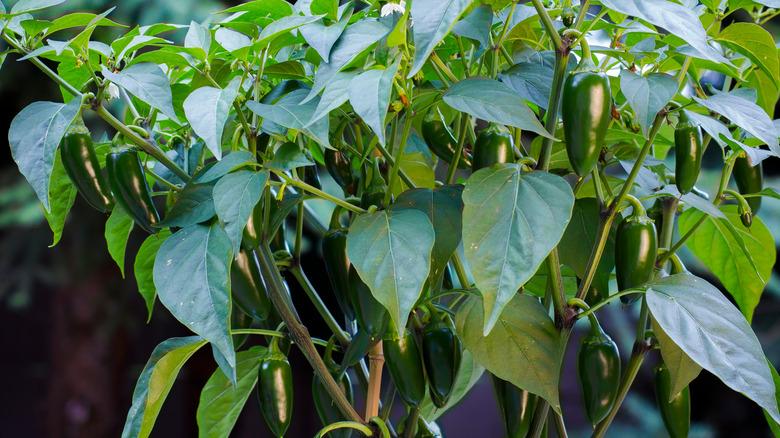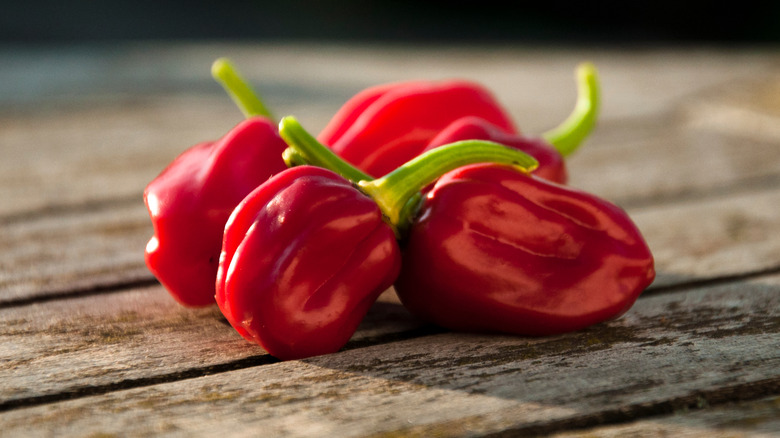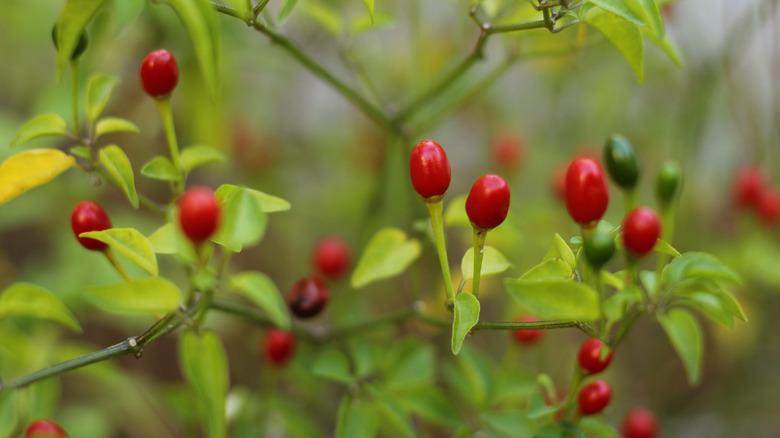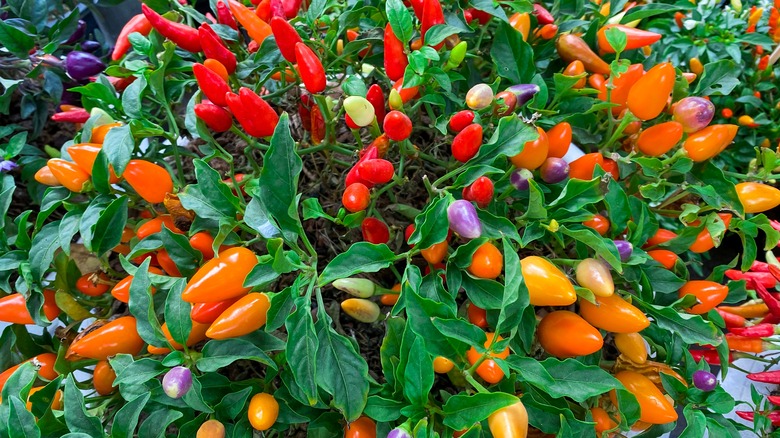15 Spicy Peppers You Can Grow In Your Garden
At the grocery store, your hot pepper options are typically limited to jalapenos, poblano peppers, and habaneros. While each of these tastes great, if you're into growing your own fruits and vegetables or making your own salsas, there are so many more hot peppers you could be growing in your home garden. From mild, spicy-sweet Hungarian wax peppers to fiery ghost peppers, you can create some Scoville variety in your kitchen right from your own backyard.
One thing to know about growing pepper plants is that there are five main species that each variety fits into. As per Missouri Botanical Garden, Capsicum annuum hosts the most common peppers that we eat in the United States today, and their spice level can range from sweet to super hot. Capsicum chinense gives way to the spiciest peppers on earth, including Carolina reapers and ghost peppers. Capsicum frutescens is used to make Tabasco and other hot sauces, while Capsicum baccatum and Capsicum pubescens both include an array of different hot peppers often found in South American cuisine. Each of these hot pepper groups has very similar care requirements. All of them need direct sunlight, well-draining soil, and warm temperatures. Once you know how to care for one pepper plant, the rest are easy to raise.
1. Cayenne peppers
Cayenne peppers (Capsicum annuum, Longum group) come from a plant that bears edible fruit, insignificant bell-shaped flowers, and glossy ovate leaves, as described by North Carolina State Extension. The cayenne pepper plant is an annual herb that can be grown in containers or in raised garden beds that are situated to receive direct sunlight and warm temperatures.
Bloom Season: Summer
USDA Growing Zone: 9 to 11
Growing Conditions: Full sun
Soil Type: Fertile and well-draining
Size: 1 to 4 feet tall and 1 to 2 feet wide
2. Anaheim peppers
Anaheim peppers (Capsicum annuum 'Anaheim') are known for their mild heat that adds flavor to several different foods and meals. As per RHS, this variety from the Solanaceae family is easy to grow indoors or outdoors. It produces its fruit in the summer and fall, which will taste the best if the plant is moved outdoors during its growing season.
Bloom Season: Spring and summer
USDA Growing Zone: 9 to 11
Growing Conditions: Full sun
Soil Type: Fertile and well-draining
Size: 4 to 20 inches tall and wide
3. Lemon drop pepper
The lemon drop pepper plant (Capsicum baccatum) can be described as tall-growing and bushy. As pointed out by Plants for a Future, this plant native to South America is best grown in a sunny, yet protected location such as in a cultivated garden or in front of a wall. With good care, the lemon drop pepper plant will produce yellow fruit that is spicy and citrusy.
Bloom Season: Summer and fall
USDA Growing Zone: 8 to 11
Growing Conditions: Full sun
Soil Type: Fertile and well-draining
Size: Up to 6 feet tall and 3 feet wide
4. Hungarian wax pepper
Hungarian wax peppers (Capsicum annuum 'Hungarian wax') are not commonly found in the grocery store, but you can grow them yourself from a young plant or a seed. According to Everwilde Farms Inc, this delicious pepper is a cross between a chili pepper and a banana pepper. These sweet and hot flavors mixed together formed a medium-hot pepper that can be pickled, used in salsa, or stuffed with meat and cheese.
Bloom Season: Summer
USDA Growing Zone: 9 to 11
Growing Conditions: Full sun
Soil Type: Fertile and well-draining
Size: Up to 2 feet tall
5. Shishito pepper
Shishito peppers (Capsicum annuum, Grossum group) are described more often as sweet instead of spicy, but they can give almost any flavorless dish a little kick. The sweet pepper plant is known for its simple leaves, bell-shaped flowers, and bushy growth habit, describes RHS. To keep your shishito pepper plant healthy, be sure to provide it with plenty of direct sunlight and well-draining soil.
Bloom Season: Summer
USDA Growing Zone: 9 to 11
Growing Conditions: Full sun
Soil Type: Fertile and well-draining
Size: 20 to 40 inches tall and 4 to 20 inches wide
6. Scotch bonnet pepper
The scotch bonnet pepper (Capsicum chinense 'Scotch Bonnet') is closely related to the habanero pepper, though it is also much spicier. As mentioned by Missouri Botanical Garden, the plant that produces these peppers can be grown in a vegetable garden, however, it also has good ornamental value due to its color-changing fruit and dark green leaves.
Bloom Season: Summer
USDA Growing Zone: 10 to 12
Growing Conditions: Full sun
Soil Type: Fertile and well-draining
Size: 1 to 2 feet tall and wide
7. Rocoto pepper
Rocoto peppers (Capsicum pubescens) are difficult to grow outdoors due to their need for consistent high temperatures. Yet, with that in mind, they can still be raised indoors or in greenhouses. As stated by Plants for a Future, rocoto peppers, which are also called tree peppers and manzano peppers, are thick-skinned, pungent, and relatively spicy.
Bloom Season: Summer
USDA Growing Zone: 9 to 11
Growing Conditions: Full sun
Soil Type: Fertile and well-draining
Size: Up to 9 feet tall and 6 feet wide
8. Ghost peppers
Ghost peppers (Capsicum chinense) can be compared to other Capsicum chinense species for their unbelievably hot flavor. This pepper is infamous for its spice that can be debilitating when eaten in even the smallest of quantities. North Carolina State Extension notes that the ghost pepper plant's high capsaicin levels can be dangerous to children, but birds are immune to the chemical compound's ill effects.
Bloom Season: Summer
USDA Growing Zone: 10 and 11
Growing Conditions: Full sun
Soil Type: Fertile and well-draining
Size: 1 to 2 feet tall and wide
9. Paprika peppers
Paprika peppers (Capsicum annuum L.) come from a somewhat low-growing and bushy plant that is native to southern Europe, says the University of Florida. The most commonly grown paprika pepper plant in America is known as the Hungarian paprika plant, which produces its fruit from summer to fall after flowering. The fruit is not commonly eaten whole. Instead, it is dried, ground, and packaged for use as a spice.
Bloom Season: Spring
USDA Growing Zone: 6 to 11
Growing Conditions: Full sun
Soil Type: Fertile and well-draining
Size: 2 to 3 feet tall
10. Tabasco peppers
Tabasco peppers (Capsicum frutescens 'Tabasco'), as you might already realize, are what give Tabasco sauce its spice. These juice-filled peppers grow on the somewhat weak and woody stems of the shrubby pepper plant, as explained by National Parks. They can be grown in some shade, unlike other Capsicum species. However, the fruit tastes best when it is exposed to full sun and given moderate water.
Bloom Season: Summer
USDA Growing Zone: 9 to 11
Growing Conditions: Full sun to partial shade
Soil Type: Fertile and well-draining
Size: 4 to 6 feet tall and 1 to 2 feet wide
11. Carolina reaper
The Carolina reaper (Capsicum chinense 'Carolina Reaper') holds the title of the spiciest pepper in the world, warns North Carolina State Extension. This member of the nightshade family should be grown in an environment where it won't accidentally be eaten by children or pets. The plant grows easily in rich soil outdoors, but you may choose to grow it in your indoor garden where you can keep a close eye on it.
Bloom Season: Summer
USDA Growing Zone: 10 and 11
Growing Conditions: Full sun
Soil Type: Fertile and well-draining
Size: 1 to 2 feet tall and wide
12. Jalapeño peppers
Jalapeño peppers (Capsicum annuum 'Jalapeno') are used in a wide array of dishes from stir fry to tacos. An annual herb in most places, National Parks says this plant grows best in warmer climates that can provide the species with fertile soil and more than 6 hours of direct sunlight per day.
Bloom Season: Summer
USDA Growing Zone: 11 and 12
Growing Conditions: Full sun
Soil Type: Fertile and well-draining
Size: Up to 18 inches tall
13. Habanero peppers
Habanero peppers (Capsicum chinense 'Roulette') are another frequently used hot fruit that you can find in many South American cuisines. The habanero pepper plant is extremely tolerant of high heat and drought, which makes it difficult to grow outdoors in most of the United States. As explained by Missouri Botanical Garden, the peppers are usually started indoors where the climate can be controlled.
Bloom Season: Summer
USDA Growing Zone: 10 and 11
Growing Conditions: Full sun
Soil Type: Fertile and well-draining
Size: 2 to 4 feet tall and wide
14. Chile Pequin peppers
Chile Pequin peppers (Capsicum annuum var. glabriusculum) are another variation of the Capsicum annuum species. These peppers are commonly compared to cayenne peppers, though they are typically a bit spicier, as said by Eco Blossom Nursery. Chile Pequin pepper plants are best grown in containers, mass plantings, or garden beds with plants that have similar care requirements.
Bloom Season: Spring
USDA Growing Zone: 4 to 11
Growing Conditions: Full sun to partial shade
Soil Type: Fertile and well-draining
Size: 2 to 3 feet tall and wide
15. Ornamental pepper
Ornamental peppers (Capsicum annuum 'Chinese Five Color') aren't just for looking pretty. This variety, known as Chinese five-color peppers, is both beautiful and tasty. The plant, which Missouri Botanical Garden describes as compact, is often grown in edible gardens where they are harvested for use in homemade hot sauces. Alternatively, they can be pickled.
Bloom Season: Summer
USDA Growing Zone: 10 to 12
Growing Conditions: Full sun
Soil Type: Fertile and well-draining
Size: 2 to 3 feet tall and 1 to 2 feet wide
